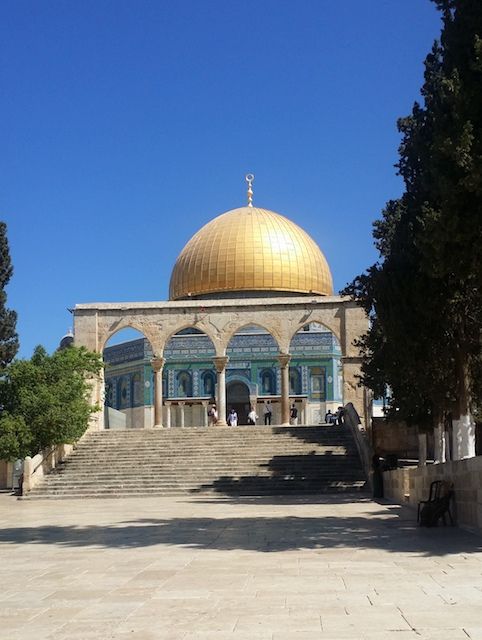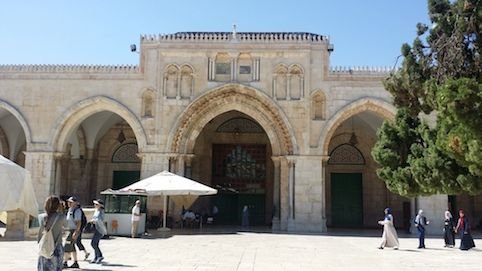First encounters in Jerusalem
The Middle Eastern events rarely reach their way to the big headlines in western media, except for the Syrian civil war and other major conflicts having global or at least far-reaching effects. In this post I will shed some light on the first days of my journey in Israel and OPT, as well as on the recent events at the precious place of the three major Abrahamic religions: Jerusalem and the Temple Mount/Al-Haram Al-Sharif.
As I arrived in Israel through Ben Gurion Airport in Tel Aviv, I had to find my way to Jerusalem in the middle of the night. Transportation affairs in the ME usually tend to require some nerves and patience but this time I was happy to see it did not: right outside the arrivals hall there were sheruts (shared taxis, arab equivalent: servicee) and their drivers waiting for the mini-van to fill up and ready to take you to your exact destination. But how about the notorious Israeli security checks then? I had heard horror stories as well as useful tips on how to manage without further hassle at the border and was prepared to answer even detailed questions regarding my visit in Israel. I also got a new passport well beforehand because I didn’t want to have any stamps or visas indicating previous visits to the ME. So, the outcome of my first round in the Israel security carousel: the smoothest pass-through ever, after a couple of very basic questions regarding my visit. Approximately 2 min from the baggage claim, through immigration and out.
Almost for two weeks before my arrival, there were clashes in Jerusalem which sparked after the Israeli security set metal detectors and surveillance cameras at the entrances of Al-Haram al-Sharif, known to the Jews as Temple Mount. The metal detectors were put in place after an attack by three Palestinian gunmen leaving two Israeli guards dead (as well as the assailants themselves). The Palestinians saw the detectors as a measure to destabilize the status quo at the site. In 1967, during the Six Day war Israel took control of the Old City of Jerusalem and the Temple Mount. However, after the war an agreement regarding the status quo was made, giving the Jews a right to visit the holy place, on the condition that they do not pray there. Carrying religious symbols or books is also forbidden when visiting the compound. Non-muslim visitors are able to visit the compound including al-Aqsa mosque, but only Muslims are granted entrance to the Dome of Rock.
This holy but contested piece of land carries a great meaning and value to Muslims and Jews alike. The Dome of Rock is believed to be the place from which Muhammad started his Night Journey to heaven, and the compound itself is the 3rd holiest place of Islam after the mosques of Mecca and Medina. For Jews, Temple Mount was the site of the First (957-586 BC) and the Second Temple (516 BC -70 AD) that were subsequently destroyed, and according to the tradition will be the site of the Third and final one.
So, back to the recent dispute. The rage started after the metal detectors and restrictions banning men under the age of 50 to enter the compound for Friday prayer were put in place, all these seen by Palestinians as an attempt to take control of the site and as a collective punishment for the attack. After Israeli police decided to remove the detectors and instead announced it would install surveillance cameras on the entrances of the mosque compound, the protests kept going, lasting up to two weeks. On Thursday 27th of July, Israeli security forces announced it would remove the cameras. The Palestinians regarded this as a victory, although a victory which cost the lives of at least six Palestinians, three Israelis and involved hundreds of wounded. However, the situation stabilized after all the new security measures were removed.
I arrived in Jerusalem Old City early in the morning, just on time when people had finished their morning prayers, marching out of the gates chanting the Shahada (en. Testimony; there is no God but God and Muhammad is the messenger of God). There was an odd situation upon my arrival to the Old City. As I got off the sherut and stopped to fix my backpack, a patrol car stopped and the officer leaned out of the window, asking me if everything was okay. What made it weird was that the officer asked it in Arabic. He didn’t try first in Hebrew or English and it’s highly unlikely he didn’t realize I’m a tourist. When I reached the Damascus gate (one of the entrances to the Old City), the soldiers, obviously bored, started to chat and ask questions, this time one of them also in Arabic. And I hadn’t said a word in Arabic before they did. Of course, there are Arabs in the Israeli security forces, but still this remains an odd coincidence. I asked my Palestinian hosts about this and they were as confused as I was.
However, I reached my hostel in the muslim quarter and after sleeping a couple of hours, I was ready to explore the bustling souqs and alleys of the Old City, as well as the Temple Mount and the Western Wall. The Western Wall was filled with people performing prayers, women on the other side and men on the other, separated by a wall. Next to the Wall on the right is a huge wooden bridge which leads to the Temple Mount. After going through careful security checks, I climbed the bridge up to the Temple Mount. The area is like a huge garden, men resting under the trees and Palestinian guards circling around. The dress code is strict and without fully covering outfit your access will be denied (no headscarf needed though). You could feel the sacred Feng shui and just sit there and watch the calm beauty of the site. Definitely worth seeing, bucket list -level!
As mentioned above, jews are allowed to visit the Temple Mount but generally it is seen forbidden by the jewish themselves. At the entrance there were signs stating that it is a sin for a jew to enter the site, instructed by the Chief Rabbinate. This is due to the unknown exact location of the destroyed temples: the place is so sacred that nobody should enter it, due to ritual impurity. So when it is unsure where they were located, people should not go there or they might accidentally step on what is the most sacred. However, nowadays it is common for jews to visit the site and during my visit there was a big group of jewish visitors, surrounded by armed-to-the-teeth guards.
After touring the old city spots, I headed to the ''modern'' centre of Jerusalem and strolled around Ben Yehuda and Yafo streets, which have nice cafés, restaurants and shops along the way.
My next stop will be Bethlehem, located some 10 km south of Jerusalem in the Palestinian Territories. Looking forward to see what the House of Meat (Bayt Lahm) has to offer!
*PS. If you spot any factual errors, feel free to correct:) I write these mostly out of my memory so errors might happen



Interesting text, seems like you have done your homework about Temple Mount. Probably very interesting for you to with your own eyes see a maybe broader picture than that presented in media of how it's to live in Jerusalem!